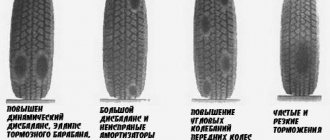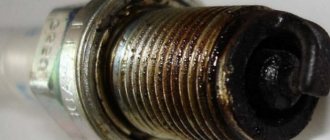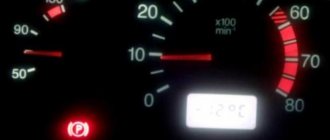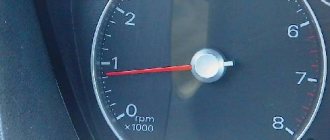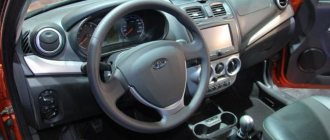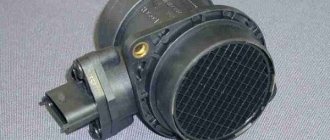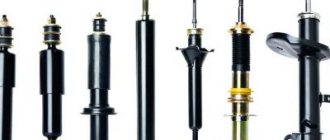One of the fairly common complaints about service stations from car owners is vibration of the steering wheel at a speed of 100-120 km per hour or so. The vibration may be barely noticeable, or, on the contrary, trembling and rattling from the steering column is transmitted to the entire front panel and other elements of the interior. There can be many reasons for this phenomenon, but what is the risk of such vibration?
- rapid fatigue;
- decreased comfort from driving and driving in general;
- rapid wear of vehicle components and assemblies;
The reasons that cause steering wheel vibration at high speeds can be divided into three groups:
Strong vibration when accelerating: reasons
Many car enthusiasts are familiar with the problem when vibration occurs when accelerating. There are many reasons for this phenomenon. Often, searching for a source can even drive a car enthusiast crazy. Let's look at the main reasons for shaking, because you really want the car to drive quietly and smoothly. In 75% of cases, the problem is detected and fixed, and the car owner can again feel calm and comfortable.
Vibration in the body and deformed rims
Often the cause of unpleasant vibrations is disc deformation. This is easily determined on balancing stands. Most often, deformations occur due to driving through potholes. The problem occurs in the spring, when their numbers increase.
If it is not possible to go to the stand, then you can try to find the dent visually. Most severely, the disc jams from the inside. Stamped steel wheels are more likely to deform than their cast counterparts.
In addition to dents, vibration at speeds of 100-120 km/h can also be caused by simply a curved disk. At the same time, the wheel can rotate smoothly on the stand. This is because it is attached to the device through the central hole. On a car, the wheel is not centered when installed. Warped discs also come from the factory.
Steering wheel shakes when accelerating
Quite often, when driving, a strong vibration occurs on the steering wheel when accelerating. At first it is barely noticeable, but over time it becomes more noticeable. This can cause serious damage and lead to an accident.
The first thing you need to do is check the wheel balancing. To do this, you can go to the nearest tire repair shop. If your wheels are out of balance, then this is one of the popular reasons for shaking when accelerating. Fixing the problem won't cost much. Sometimes the disc becomes clogged with dirt or snow, then these beatings can occur and stop. It is very easy to determine the presence of dirt with alloy wheels, but with steel wheels, where the ventilation holes are small, it is difficult. Dirt collects inside the part.
Checking filters
The fuel system of a modern car is equipped with at least three filters. The first of them is, in fact, just a mesh that serves to trap solid particles. It is placed in the neck of the tank, but it is not capable of becoming clogged to such an extent that fuel does not enter the cylinders. In this regard, this filter cannot be the reason that the VAZ-2114 twitches when driving.
The other element is mounted on the fuel pump, which is submerged in the tank. This is the same grid, only with smaller cells. However, the functions are basically the same - to retain large debris. For this reason, it is also clear that it is also not capable of becoming very clogged.
The third element is located after the fuel pump, and it is this filter (it serves for fine cleaning) that can become so clogged that the pump will one day stop coping with its duties.
At the same time, some models may have several additional filters installed. And they may well cause the car to jerk.
The need for balancing
Neither tires nor wheels are perfect in terms of geometry and composition. So, due to different masses in different parts of the wheel, those places where the weight is greater will pull the wheel axle towards themselves. At high speeds, the force will be transmitted to the rods, then to the steering wheel.
It is very important to perform balancing from time to time. Especially after changing tires or wheels. Using this procedure, you can equalize the masses of the wheels at each point. Driving a vehicle with unbalanced wheels can cause rapid wear on the chassis and suspension, a problem that is more difficult to correct.
Manifestation of the problem
As a rule, if the car jerks, this is usually due to various circumstances. Every driver should understand that any non-standard situations do not appear out of nowhere; this may be due to a malfunction of a particular system. In turn, this is usually due to wear and tear on vehicle components. And if you lose sight of this, sooner or later, it can result in serious and costly repairs.
As for when the problem begins to manifest itself, vehicle jerking can be noticed in the following cases:
- Only when the car starts moving.
- When the engine is running at low speed.
- During a sharp increase in speed.
- When the car is moving at high crankshaft speeds.
- In any mode of vehicle movement, which is manifested by periodic jolts at different times.
But what exactly can cause a vehicle to behave this way? When a VAZ-2114 jerks while driving, there may be several reasons for this, and quite a few. In fact, this is what we will discuss further.
Unreliable wheel mounts
This problem is also easy to fix and diagnose. This is a simple but very dangerous reason. The fastenings can be loosened even on one wheel, and this is enough to cause shaking. If the problem is not resolved in time, emergency situations may occur. If the wheel falls off while driving, the repair will be quite expensive - you will have to replace the disc and hub, and the brake disc.
The symptoms in this case are very similar to vibrations due to tires or bent wheels. But there is a cyclical pattern here, although not at all speeds.
Wheels
If, when the car reaches a certain speed, the steering wheel begins to shake, first of all you need to pay attention to the condition of the wheels and tires.
A broken slope is a car tire that has become deformed due to an impact or falling into a hole and has a bump or other distortion on its surface. And if at lower speeds such a problem manifests itself little, then with increasing speed, vibration also increases. It is almost impossible to eliminate the deformation of a tire; you can move the wheel on which such a tire is mounted back. Perhaps in this case the vibration will decrease, but the damaged ramp will have to be replaced, one way or another.
Installing tires that do not match the surface can also cause the steering wheel to vibrate at speed. For example, if you install off-road tires, then on a normal highway, vibration may occur.
Misaligned side members, or other deformation of the car frame, can lead to incorrect wheel alignment angles. In this case, they say that the car is eating rubber. But in addition to rapid tire wear, vibration in the steering wheel may occur when a certain speed is reached.
Poorly tightened nuts that secure the wheels can easily cause the steering wheel to shake at high speed, and this is already very dangerous. Therefore, do not forget to check the condition of your wheels, as well as the reliability of their fastening.
Impaired wheel rim balancing is probably one of the most common causes of steering wheel vibration that occurs at speed. Balancing may be disrupted due to dirt adhering to some part of the wheel rim, due to a hole caught at speed, or other shock impacts on the wheel. In principle, it is possible to restore the imbalanced wheel rim, but it can no longer be called ideal. Except, of course, the case of dirt sticking. It just needs to be removed from the wheel.
Checking the suspension and chassis
Vibration when accelerating can occur as a result of natural wear and tear on the struts or shock absorbers. The suspension stops working smoothly, which is one of the causes of the problem. This can be especially noticeable on rough roads or when driving at speed.
Another popular cause of shaking is the support bearing on the strut. This part can be found on top, above the shock absorber. It is also checked under the hood from the front. If you can find a worn bearing, you should replace it, and then the problem will be solved.
Ball joints in most cases wear out due to driving on poor quality roads. In our country, these parts need to be changed very often. If you find play in the supports, then perhaps by replacing it you will be able to regain your comfort.
Check and, if necessary, replace the tie rod ends. Over time, play appears in this mechanism due to wear. Thanks to this tip, the car's wheels can turn parallel. Worn tips cause shaking.
Self-diagnosis
Determining, using a visual inspection, the exact cause of vibration of the steering wheel when driving is not immediately possible, even for professionals. To facilitate diagnostics when identifying a defect, you must:
- Drive onto a section of flat and dry road that allows your car to reach a speed of up to 100 km/h.
- Accelerate smoothly to the maximum permitted speed.
- Drive 1-2 km without acceleration in this mode.
- Reduce speed to minimum.
You should pay attention to what mode of movement vibration appears, how strong it is, whether longitudinal or transverse vibrations predominate and at what moment it disappears. These are the questions that specialists will ask you when you contact a professional service center.
It should be taken into account that on some models of the domestic and Chinese automobile industry, a slight vibration on the steering wheel is acceptable by the manufacturer and only with increasing amplitudes, it is necessary to take measures to identify the causes of the occurrence.
Vibration when accelerating
This is terrible, especially when you need to accelerate quickly, for example if you need to overtake another car. Often when you press the pedal, acceleration is jerky and uneven. To make a correct diagnosis, you need to follow a few simple steps.
Check the oil level in the gearbox. Surprisingly, low transmission oil levels cause vibrations and shaking during acceleration. The car may also noticeably lose its dynamic characteristics. Jerking when pressing the accelerator pedal - this can also be a consequence of a lack of oil.
A dirty automatic transmission filter leads to various unpleasant effects. You can do the replacement yourself or use the services of specialists.
A worn driveshaft is a guaranteed noticeable vibration of the car when accelerating. The weak point here is the cross. Replace the part if necessary, otherwise it may cause more serious damage.
Also, such a nuisance can be caused by uneven engine operation. This often happens after renovations. Sometimes service station professionals simply forget to balance the crankshaft and flywheel. Another reason is an incorrectly configured carburetor.
The accelerator also cannot be discounted
At the moment when the driver sharply presses the accelerator pedal, there is a rapid increase in crankshaft revolutions. However, this may cause the vacuum ignition angle regulators to malfunction. Ultimately, the distributor lags at low speeds, and the car begins to jerk.
As the crankshaft speed increases, the engine needs to work faster, igniting and admitting the fuel-air mixture. However, if there are problems with the vacuum regulators, there may be problems with opening the throttle valve and it will not be possible to quickly increase the speed. As a result, gasoline burns at the wrong time, which can damage the bearing responsible for the ignition timing.
To confirm or refute the problem when the VAZ-2114 jerks while driving, it is worth checking the vacuum regulators. Diagnostics is done like this: before starting the engine, you should remove all the pipes with hoses, first covering them with your hands. While the engine is running, you can hear the retractor effect of the regulators.
However, if a vacuum does not form during the working mixture, then the cause of the leakage lies precisely in the damper. The element needs to be replaced.
Engine mounts, gearbox mounts and other reasons
This is another possible group of reasons why a car may shake when accelerating. All these problems can arise for various reasons. For example, as a result of examinations, a breakdown of one of the power unit airbags is discovered. It's easy to find out - increase the engine speed when vibrations appear.
Body vibration when accelerating from 80 km/h to 100 km/h can also occur if there is a problem with the gearbox. Testing this hypothesis is very simple. It is recommended to reach a speed of about 85 km/h, then depress the clutch pedal and watch how the car behaves. Engage third gear and release the clutch. Accelerate from 50 km in the last gear of the transmission.
If the nature of the beats does not change during all these events, the gearbox is not to blame. If the vibration level increases when the box is connected to work, then you can check its involvement.
This method is suitable for both manual transmissions and automatic transmissions. In the case of an automatic transmission, at speeds of approximately 90 km/h, turn on 3.2, D, N on the gearbox, and then monitor the operation of the automatic transmission and the car. Watch the vibrations. Most often, the fault of the box in beating is minimal, but practice shows that there is such a possibility.
Air filter?
As is known, the formation of an engine working mixture requires a certain amount of air in which oxygen is present. And without it, the combustion process itself is impossible. In a car, before entering the working chamber, the air passes through the labyrinths of the filter and only after that it combines with the fuel mixture, forming just the working composition.
However, if this element is contaminated, the car may also begin to jerk while driving or when starting off. As a result, the flow decreases significantly and there is simply no longer enough air in the required quantity. This risks the working mixture becoming rich in fuel and burning incorrectly.
As a result of this, the VAZ-2114 jerks when driving, and in some cases there may be misfires.
What else should you pay attention to?
Vibration when accelerating can be felt due to unreliable mounting of the engine and exhaust system parts. It is better to perform this check with the engine running and then turned off. There are also cases when shaking is caused by a damaged radiator fan.
Next, check the attachment. Often the problem can be solved by replacing the drive belts or balancing the pulley. It would be a good idea to check the clutch basket and flywheel. You can do this as follows. Depress the clutch and place the selector in first gear. Next, start the engine and wait a couple of seconds. Then the lever is moved to the neutral position and the foot is removed from the pedal. Are there still vibrations? Look for the problem in the flywheel and clutch basket.
Braking system malfunction
The appearance of “beating” of the steering wheel during braking is a sign of a malfunction of parts of the brake system. In this case, you need to check:
- Disks.
- Drums.
- Degree of wear and reliability of installation of linings.
Premature failure of these components indicates a manufacturing defect, installation of uncertified spare parts or improper operation (overheating after prolonged braking). In this case, it is necessary to replace unusable parts with new ones and check the reliability of the brakes.
Let's sum it up
So, common causes include wheel mounts, loose brake discs, a deformed drive shaft, constant velocity joints, and wheel bearings.
Vibration occurs when accelerating from anything. There are a lot of reasons. But if you try, you can detect them yourself and not pay for diagnostic services at a service station. But if suddenly you can’t figure it out on your own, don’t put off the decision. This leads to bad consequences. With simple steps, you will definitely find the causes of vibrations in your car and eliminate them. Take malfunctions seriously, because a neglected problem can cause an accident.
Didn't find the information you are looking for? on our forum.
The wheel alignment is broken
Directly depending on the incorrectly set angle, vibration can only occur during acceleration or in a certain speed range. Incorrect wheel alignment can be detected very quickly - tires wear unevenly.
If only the outer or only the inner part is wiped, then this is the same situation. The problem can be corrected by adjusting the angles. Then the vibration in the body at a speed of 100-120 km/h will disappear.
But the camber/toe has been adjusted, but the problem has not gone away. The angle has been corrected, that's a fact. But the car owner decided not to change the tires, because they can still drive. But the tires “drive” the way they are used to. This means that you need to change the tires or drive at low speeds for a period of time, then the tread will wear out evenly and the problem will be solved.
Lada Granta › Logbook › Getting rid of engine vibration part 2. Inspection of the throttle
1 Cleaning and lubricating the throttle
Lately the car has become very annoying with the throttle behavior. The car reacted nervously and with a slight delay to pedal presses, the idle speed fluctuated greatly, and releasing the gas was like a blow. I went for spring diagnostics for 299 rubles. Everything is fine, no electrical problems. I checked the spark plugs and changed the fuel. There was no effect, I tried to remove and clean the throttle, but knowing AvtoVAZ I decided to look at the condition of the E gas reducer. I bought a throttle cleaner and got to work. When I unscrewed the throttle nuts, the studs came out with them. The studs are held inside the plastic manifold by nuts; they fell out. I had to look for new ones and use thread glue. The damper was crap quite badly, especially around the axis of rotation. I slightly lifted the flap and turned it; it moved with little effort and stuck. A view opened up to the end of the damper; there was a lot of carbon deposits on it, which interfered with the passage of air at idle. Hence the sausages at low speeds. I washed everything, blew it with a cleaner from the heart. The biggest surprise was waiting inside the gearbox. We open it and see a completely dry gearbox. Not a drop of grease on the gears. The idler gear shaft has wear and plastic dust from the gear. And there’s actually an oval hole in the lid! I blew it out and lubricated it, very little lubrication is needed. A little inside the idler gear, a little into the cover and onto the drive gear of the engine. We close everything and put it in place. The result is excellent. Before cleaning and inspection: — Starting the engine was accompanied by vibration and floating speed. — Idle speed fluctuated greatly from 830 to 950 revolutions, sharply and with dips. — Acceleration up to 2500 rpm was sluggish, after 2500 it was like a kick. The car accelerated faster. — The release of gas was accompanied by a strong nod, which created discomfort in the flow. — The overall reaction to the gas pedal was very sluggish. — Squeaking sound when the ignition is turned on. After cleaning and inspection: - Now the engine starts, somehow abruptly, the speed is stable, vibrations are minimal - Idle speed has become more even, floating within 860 - 900 revolutions. — Acceleration is now smooth throughout. There is no such jerk after 2500. — The throttle release is smooth, the needle falls smoothly
Content
If within the city limits this is not yet catastrophic - you called a tow truck or asked for a rope and went to figure it out - then on long trips the prospect of spending the night in an open field looms without hope of quickly reaching at least some populated area.
Vibration in the body at a speed of 100-120 km/h can be caused by various reasons, from completely innocent ones to those requiring serious intervention in the inside of the car. But in half of the cases, you won’t even need to diagnose or replace any parts.
